Intel’s Discrete GPU Era Begins: Intel Launches Iris Xe MAX For Entry-Level Laptops
by Ryan Smith on October 31, 2020 12:01 PM ESTIntel’s Vision for Sharing Work: Deep Link & Additive Ai
As mentioned towards the start of this article, Intel is taking an interesting tack with Xe MAX. From a graphics standpoint, the company has not developed a multi-GPU solution to combine the rendering power of Xe MAX with Tiger Lake’s iGPU. As a result, Xe MAX is not significantly more powerful than Tiger Lake’s iGPU for 3D rendering/gaming tasks, greatly limiting the utility of Xe MAX for gaming purposes.
Although this wipes out the obvious route for using Xe MAX to augment Intel’s iGPU – and thus make Xe MAX a significant upgrade for graphics purposes – on the whole it’s a decision that makes sense for Intel. Multi-GPU graphics is hard, and it’s only getting harder. Even NVIDIA, with all of its experience in the field, has essentially pulled out as of their latest generation of hardware, thanks to rendering techniques getting less and less multi-GPU friendly. So what chance would Intel have, especially with such low-end hardware? Probably not much.
But that doesn’t mean that Xe MAX doesn’t have a purpose. Even if it can’t be used to help with any single task/thread, it can still handle additional tasks/threads, essentially having it function as a co-processor to offload tasks to or to spin up extra tasks on. This is a use case that professional-grade video cards and associated software have supported for a number of years, and it’s the same route Intel is taking with Xe MAX.
This kind of functionality is a core part of what Intel is terming its Deep Link technology, which is their umbrella name for all of the technologies backing and abilities sprouting from using Intel’s CPU and dGPU together. In practice, Deep Link is Intel’s software and firmware stack for Xe MAX, ranging from how they’re balancing TDP allocations between the CPU and GPU, out to how they present the additional processing blocks from an Xe MAX GPU to software so that it can easily use them. There is no real hardware magic here – as previously mentioned, Intel is using a standard PCIe 4.0 x4 link back to the CPU – but the company sees the synergy between their CPUs and Xe MAX as being a defining factor of the graphics solution – and why customers would want it.
Arguably the most critical part of Deep Link is what Intel is terming “Additive Ai”, which is the ability to use the iGPU and dGPU together within a program. As previously mentioned, Intel’s focus here is on enabling developers to use Xe MAX for additional workloads. Among other things, Intel’s examples have included using Xe MAX’s compute resources for batch processing images in Gigapixel AI, and using the chip’s video encode blocks to increase the number of video streams that can be simultaneously encoded.
This sort of batch-focused software is the ideal use case for Xe MAX. If a task can be broken down into multiple independent pieces, then it can easily be farmed out to both GPUs simultaneously – and thus justifying adding Xe MAX to the mix rather than just relying on Tiger Lake’s iGPU.
As for what software can use these capabilities, conceptually any software that can handle issuing work to multiple GPUs is in a good place. Even if it can’t handle Xe MAX out of the box, it should take very little work to get it seeing multiple Intel GPUs. Otherwise, this is where Intel’s control of the software stack should be an advantage, as it gives them opportunities to abstract certain parts of the multi-GPU equation from software developers. Though at the end of the day, that software still needs to be able to issue independent workloads to properly make use of Xe MAX.
The need for independent workloads and batch processing, in turn, is why Intel is focusing on what they term “mobile creation” workloads. These tasks aren’t typically processed in real-time, and broadly speaking have the greatest overlap with what the Xe MAX hardware can do. So although Xe MAX isn’t especially useful as stand-alone graphics adapter, Intel sees it as an excellent accelerator.
Overall, Intel is still in the early days of software support for Deep Link and Xe MAX. The company is working with software developers to get multi-GPU support added to more software down the line, so that more programs can take advantage of farming work out to Xe MAX. Along with getting more batch-style software enabled, the company is also working to enable Xe MAX to help with large, single-stream video encoding. Since video encoding is not hard-bound to being a serial task, Intel is looking at ways to split up a large encoding job so that each Xe encode block gets a chunk of the video to work on, a similar process to how multi-core CPU encoding works today. For now, Intel is targeting the first half of next year.
Sharing Power: Extending Adaptix to dGPUs
Along with sharing work, Deep Link also encompasses Intel’s technology for sharing/allocating power between their CPUs and Xe Max. Intel calls this Dynamic Power Share, and its an extension of their Adaptix power management technology, which the company has offered since Ice Lake.
Intel’s Adaptix is a suite of technologies that includes Dynamic Tuning 2.0, which implements DVFS feedback loops on top of supposedly AI-trained algorithms to help the system deliver power to the parts of the processor that need it most, such as CPU, GPU, interconnect, or accelerators. With Adaptix enabled, the idea is that the power can be more intelligently managed, giving a longer turbo profile, as well as a better all-core extended turbo where the chassis is capable.
Intel already uses Adaptix to allocate power between their CPU cores and iGPU, among other blocks, so extending it to include Xe MAX is a natural (and necessary) extension of the technology. According to Intel, the company has also learned a great deal from their previous dGPU-style effort, Kaby Lake-G and its on-chip AMD dGPU, which they have taken into account when extending Adaptix for Xe MAX.
Like Adaptix for CPUs, just how well this feature is used is going to be largely in OEM hands. Intel provides the tools, but it’s up to OEMs to set their various tuning values and plan for how that interacts with the power delivery and cooling capabilities of a laptop. But with Intel starting small on Xe MAX’s rollout – there are only 3 laptops shipping this year – hopefully it means Intel has been able to give the OEMs and the devices an appropriate level of attention.
Ultimately, Intel considers Adaptix/Dynamic Power Share to be another software-driven advantage for their gear. From a competitive standpoint the company believes that their tech does a better job of power management than how MX350-enabled laptops handle power allocations – particularly, that Xe MAX laptops don't have to permanently and continually reserve thermal and power headroom for the dGPU – and thus can unlock more performance even in CPU-limited workloads. That said, it's a bit of a dubious (or at least, non-intuitive) claim, as laptops have been able to shut off dGPUs for years now. But, as is often the case with power-saving features, how well any of this is tuned in shipping system is up to the OEMs – and Intel says that they've found that most systems in this class with (rival) dGPUs aren't allocating the CPU its full headroom.
A Word on Gaming Performance
Since Intel lacks a way to combine multiple GPUs for a single rendering/gaming task, the company is not really pushing Xe MAX as a gaming solution for obvious reasons. Nonetheless, on paper Xe MAX should be faster than Tiger Lake-U integrated graphics by around 20% thanks to the discrete adapter’s higher clockspeeds, so there are potential advantages to gaming on Xe MAX. So it’s something that Intel is making sure to support all the same.
The final pillar for Intel’s software stack, Xe MAX’s drivers include an arbiter of sorts to help direct games to use the correct GPU. The “correct” GPU in this case is often – but not always – the Xe MAX GPU. But in a surprising (and welcome) bit of transparency from Intel, the company admits that in some scenarios Tiger Lake’s iGPU may outperform Xe MAX, and as a result those games shouldn’t run on Xe MAX. So the arbiter’s job is to direct a game to use whatever Intel’s software has deemed the best choice for a given game, be it the iGPU or the dGPU.
This is another case where Intel will be providing a degree of abstraction, ideally hiding all of this from a game developer. Unless a game specifically goes ahead and implements support to detect and select from multiple GPUs, then Intel’s drivers should pick the right GPU for a game.
Functionally, all this sounds very close to how NVIDIA’s Optimus technology works, just with an added wrinkle of purposely sending some games to the iGPU rather than favoring the dGPU for all games. Now that Intel has mobile dGPUs they need a way to manage their use, and this is it. Plus Intel’s long-term plans of course call for more powerful Xe-HPG GPUs, so getting their GPU switching tech out and debugged now is going to benefit them in the long run.
As for performance expectations, with Xe MAX’s higher clockspeeds, Intel is promoting Xe MAX as being generally performance competitive with MX350. Mind you, Intel isn’t aiming to set a very high bar here, but Xe MAX should at least be good for 1080p gaming (most of the time).
Launch Laptops: Acer, ASUS, & Dell
Last but not least, let’s take a look at the first laptops that will be shipping with Xe MAX graphics. Intel is starting things off with a relatively small number of laptops, with Acer, ASUS, and Dell all set to release their Xe MAX-equipped notebooks in November. These are the Acer Swift 3X, the ASUS VivoBook TP470, and the Dell Inspiron 15 7000 2in1.
All three laptops generally fit the thin-and-light paradigm that Intel is pushing with Xe MAX. The Swift 3x is a 14-inch laptop at 3lbs, and the VivoBook Flip TP470 is 14-inches as well at a slightly heavier 3.3lbs. Finally, Dell’s Inspiron is a 15-inch convertible notebook that weighs around 4lbs. All of these notebooks come with high-end versions of Intel’s Tiger Lake-U SoCs using G7-class iGPUs.
At this point we’re still waiting for pricing info on the complete set of laptops. With this being a major Intel launch Intel is going to want to put their best foot forward – and will likely eat most of the marketing costs in the process – though at the same time the company is looking to sell Xe MAX-equipped laptops as premium notebooks, so there is a careful balance to be had.
Officially, Xe MAX is launching today. However it’s not immediately clear whether any of these laptops are actually going to be available right away, or if they’re going to show up later in the month. So it may be a couple of weeks until there’s actual retail availability. On which note, as far as regional distribution goes, the Acer laptop will be China-only, the ASUS laptop will be sold in both China and North America, while the Dell will be North America-only (sold via Best Buy).
Overall, the launch of Intel’s Xe MAX graphics and the DG1 GPU is an important day for Intel, but this is also a launch that strikes me as Intel having modest expectations. Xe MAX is only being launched in a small number of laptops for now, and Intel is not seriously chasing the gaming market with their first discrete laptop part. None the less, it will be interesting to see what kind of traction Intel can get as a new player in the market, especially with their focus on mobile creation and selling Xe MAX as an accelerator for productivity and content creation tasks. No matter what, Xe MAX will be something that bears keeping an eye on.


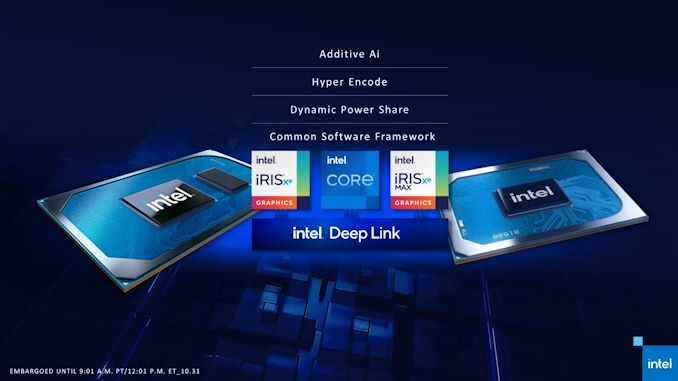
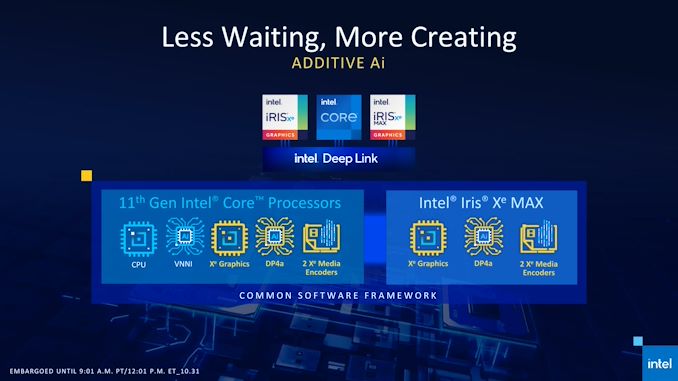

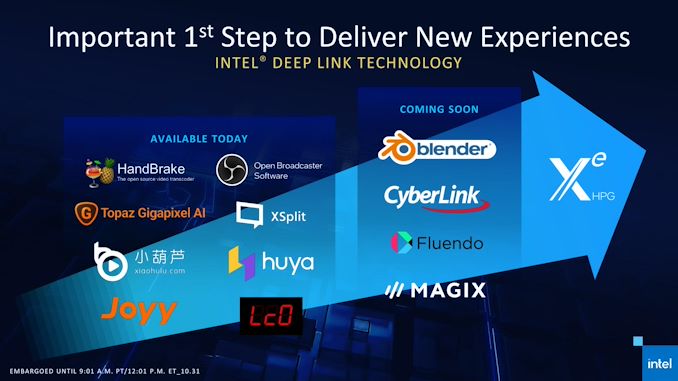
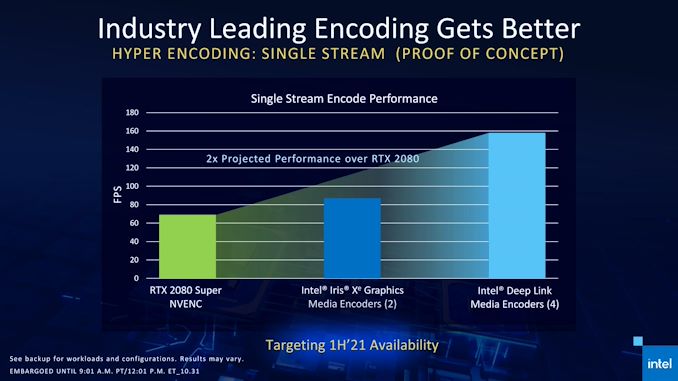

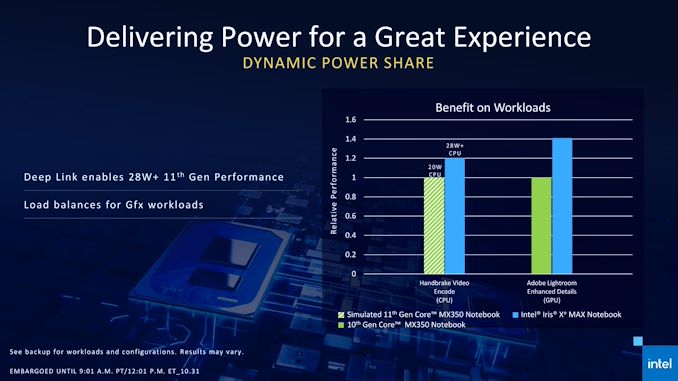
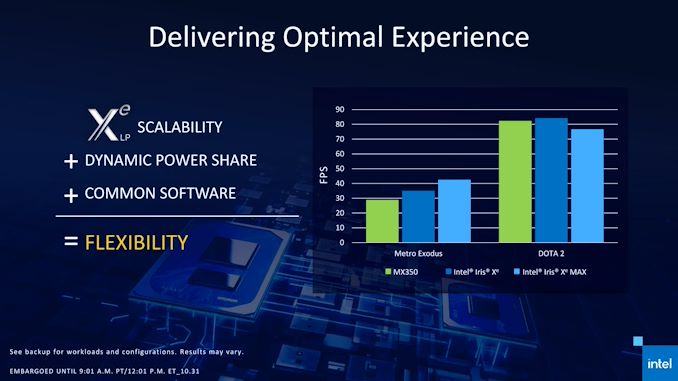
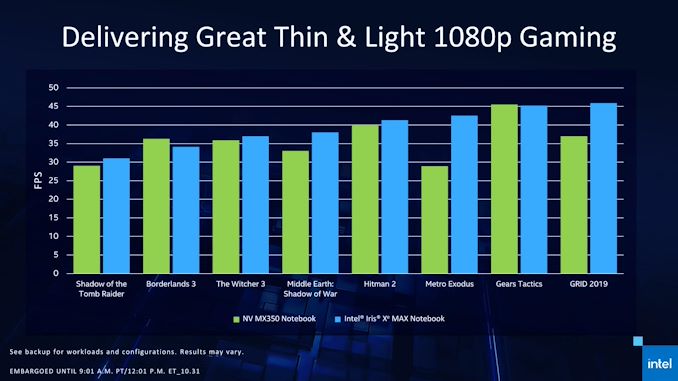




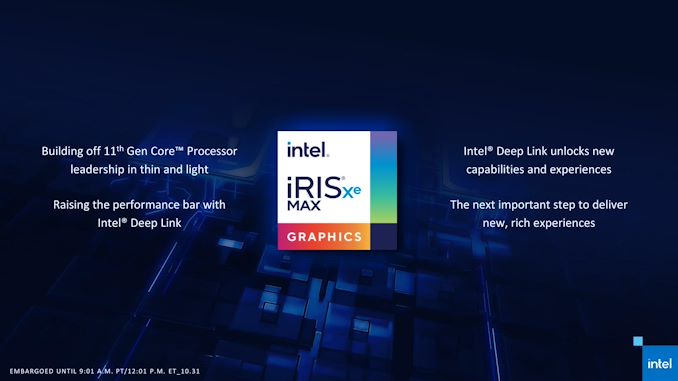














118 Comments
View All Comments
lmcd - Thursday, January 28, 2021 - link
Didn't get around to refuting your utter garbage comment. The drivers might be the same, but OEMs can push custom drivers. I get custom drivers pushed over my manually-installed ones basically every 4-6mo, and they break the control panel.HarryVoyager - Saturday, October 31, 2020 - link
That's an interesting though. Could these actually be failed Tiger Lake chips that they are simply harvesting for the GPUs, to sell rather than scrap?Kevin G - Sunday, November 1, 2020 - link
Tiger Lake has a different reported die size than Iris XE Max. However there is no reason why Intel couldn't crippled TigerLake SoCs with the CPU portion disabled. It is about harvested the maximum amount of semi-functional dies and if there are enough Tiger Lakes without functional CPUs (or say 1 or 2 cores) or enough where the CPU side fails at power consumption binning, it could happen as a limited OEM only SKU. Such OEM specific SKUs are rarely available at launch so it'll be several months before such part appears and it'll do so with little fan fair.Spunjji - Monday, November 2, 2020 - link
Intel do have prior for selling "coprocessors" that are an entire CPU, so it wouldn't be the first time. They seem to be claiming it'a a real dedicated GPU, though, albeit one that appears to reuse the CPU's memory controller. It does seem a bit odd for them to use precious 10SF capacity for additional products when they can't get out their 8-core TGL, too. Curious stuff.The_Assimilator - Saturday, October 31, 2020 - link
So it appears that Intel's "discrete" GPUs are just going to be derivatives of their same old tired rubbish iGPUs.This product, in particular, will only be chosen by OEMs until NVIDIA decides to adjust the price of the MX450 to undercut it. Intel's sole accomplishment with this GPU, therefore, is to force the retirement of the MX350... almost certainly not what they were hoping for.
Spunjji - Sunday, November 1, 2020 - link
100%vladx - Saturday, October 31, 2020 - link
Do it's a GPU solely for video encoding, that's pretty neat especially if they make it available to NUCs.eastcoast_pete - Saturday, October 31, 2020 - link
This and possible future dGPUs for laptops makes a lot of sense for Intel. Laptops, especially light and ultralight ones, are a key profit center for Intel, so trying to own a large share of the dGPU space there makes sense. The biggest question that only a test can answer is how does Intel's iGPU/dGPU solution compare to AMD's big iGPU in Renoir, especially the 4800/4900 models. If Intel's Xe can't beat the graphics performance of those, this is pretty much useless. If they can beat the 7 or 8 Vega cores in Renoir AND pull even with NVIDIA's MX350, Intel has a leg to stand on. So, test please!eastcoast_pete - Saturday, October 31, 2020 - link
And by beating built-in Vega, I mean by more than 1-3 fps. It has to be pretty decisively, or Renoir's better CPU performance will always wipe the floor with Tiger Lake.lmcd - Saturday, October 31, 2020 - link
Tiger Lake is confirmed to pass Renoir, which sort of sandbagged on iGPU performance this generation.Renoir vs Tiger Lake favors Renoir due to core counts, in part aided by how tiny Renoir's GPU is. It'll be interesting how AMD manages a larger iGPU alongside an 8-core laptop part. I hope they can do it but I doubt it'll be cheap, or widely available for purchase. After all, it'll be the biggest die they produce (that requires low leakage, anyway).